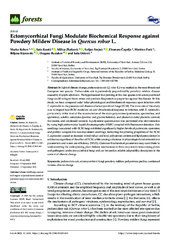Приказ основних података о документу
Ectomycorrhizal fungi modulate biochemical response against powdery mildew disease in Quercus robur L.
| dc.creator | Kebert, Marko | |
| dc.creator | Kostić, Saša | |
| dc.creator | Zlatković, Milica | |
| dc.creator | Stojnić, Srđan | |
| dc.creator | Čapelja, Eleonora | |
| dc.creator | Zorić, Martina | |
| dc.creator | Kiprovski, Biljana | |
| dc.creator | Budakov, Dragana | |
| dc.creator | Orlović, Saša | |
| dc.date.accessioned | 2022-10-13T08:57:08Z | |
| dc.date.available | 2022-10-13T08:57:08Z | |
| dc.date.issued | 2022 | |
| dc.identifier.issn | 1999-4907 | |
| dc.identifier.uri | http://fiver.ifvcns.rs/handle/123456789/3133 | |
| dc.description.abstract | In light of climate change, pedunculate oak (Q. robur L.) was marked as the most threatened European tree species. Pedunculate oak is particularly jeopardized by powdery mildew disease caused by Erysiphe alphitoides. We hypothesized that priming of this tree species with ectomycorrhizal fungi could mitigate biotic stress and produce bioprotective properties against the disease. In this study, we have compared oaks’ foliar physiological and biochemical responses upon infection with E. alphitoides in the presence and absence of ectomycorrhizal fungi (ECM). The main aim of this study was to inspect how ECM modulate an oak’s biochemical response to infection with E. alphitoides, particularly at the level of the accumulation of the main polyamines (putrescine, spermidine, and spermine), soluble osmolytes (proline and glycine betaine), and phenolics (total phenolic content, flavonoids, and condensed tannins). A polyamine quantification was performed after derivatization by using high-performance liquid chromatography (HLPC) coupled with fluorescent detection. Oak seedlings inoculated with ECM fungi exhibited significantly higher levels of putrescine, spermine, and proline compared to non-inoculated seedlings, indicating the priming properties of the ECM. E. alphitoides caused an increase in individual and total polyamine content and lipid peroxidation in oak leaves regardless of the effect of ECM, while causing a decrease in physiological and antioxidative parameters and water use efficiency (WUE). Common biochemical parameters may contribute to understanding the underpinning plant defense mechanisms in three-way interactions among plants and pathogenic and ectomycorrhizal fungi and can be used as reliable adaptability descriptors in the context of climate change. | sr |
| dc.language.iso | en | sr |
| dc.publisher | Basel : MDPI | sr |
| dc.relation | info:eu-repo/grantAgreement/ScienceFundRS/Promis/6066613/RS// | sr |
| dc.rights | openAccess | sr |
| dc.rights.uri | https://creativecommons.org/licenses/by/4.0/ | |
| dc.source | Forests (Basel) | sr |
| dc.subject | climate change | sr |
| dc.subject | condensed tannins | sr |
| dc.subject | proline | sr |
| dc.subject | polyamines | sr |
| dc.subject | powdery mildew | sr |
| dc.subject | ectomycorrhizal fungi | sr |
| dc.subject | pedunculate oak | sr |
| dc.title | Ectomycorrhizal fungi modulate biochemical response against powdery mildew disease in Quercus robur L. | sr |
| dc.type | article | sr |
| dc.rights.license | BY | sr |
| dc.citation.issue | 9 | |
| dc.citation.rank | M21 | |
| dc.citation.spage | 1491 | |
| dc.citation.volume | 13 | |
| dc.identifier.doi | 10.3390/f13091491 | |
| dc.identifier.fulltext | http://fiver.ifvcns.rs/bitstream/id/8795/2022_forests-13-01491.pdf | |
| dc.identifier.scopus | 2-s2.0-85138493907 | |
| dc.type.version | publishedVersion | sr |


